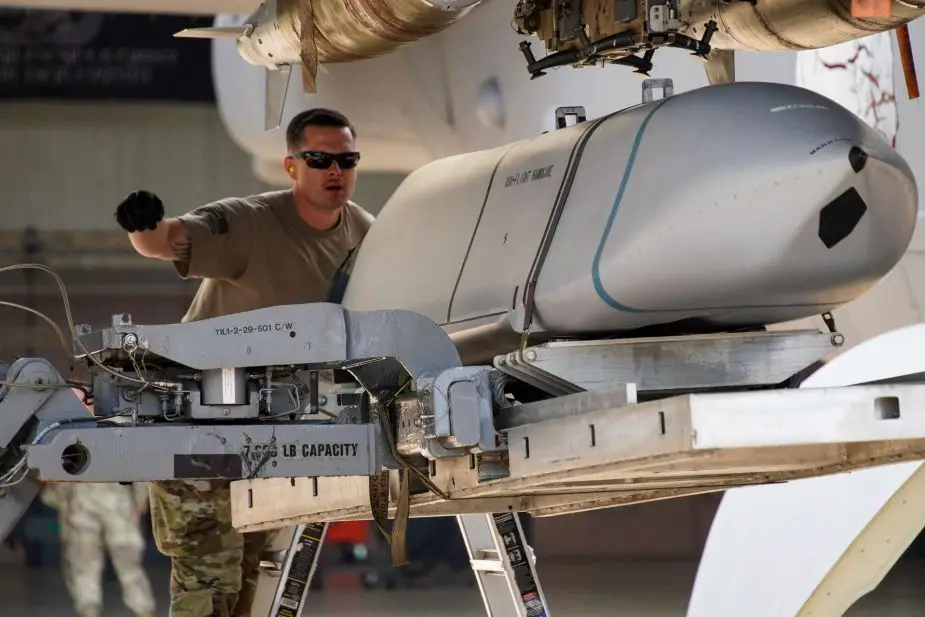Breaking News
Breaking News: US Nears Agreement to Supply Ukraine with JASSM Long-Range Cruise Missiles.
According to information reported by Reuters on September 3, 2024, the United States is close to finalizing an agreement to supply Ukraine with advanced long-range cruise missiles, a significant development in the ongoing conflict with Russia. The Biden administration is expected to announce the inclusion of Joint Air-to-Surface Standoff Missiles (JASSM) in a weapons package this autumn. However, the delivery of these missiles may be delayed by several months due to ongoing technical considerations.
Follow Army Recognition on Google News at this link

U.S. Air Force Staff Sgt. Seth Blackwood, 363rd Training Squadron Aircraft Armament instructor, directs the installation of an AGM-158 JASSM onto a B-52 during a Combat Capability Demonstration. (Picture source: U.S. DoD)
The Joint Air-to-Surface Standoff Missile (JASSM) is one of the most sophisticated and versatile weapons in the U.S. military's arsenal, developed to engage heavily defended, high-value targets at significant distances. Manufactured by Lockheed Martin, this missile was specifically designed to penetrate and destroy enemy fortifications while minimizing exposure to advanced air defense systems.
Developed in the 1990s and first entering service in the early 2000s, the JASSM was initially designed to meet the U.S. military's need for a long-range, precision-guided missile that could be launched from a variety of platforms, including strategic bombers like the B-1B Lancer and B-52 Stratofortress, as well as fighter aircraft like the F-16 Fighting Falcon and F-35 Lightning II. Over time, the missile has been continuously upgraded, with the latest variants offering extended range and improved targeting capabilities.
The JASSM features an advanced guidance system that combines GPS-aided inertial navigation with an imaging infrared seeker. This dual-mode guidance system enables the missile to autonomously identify and lock onto its target during the final phase of its flight, ensuring exceptional accuracy even in environments where GPS signals might be jammed or degraded.
Stealth is a key aspect of the JASSM's design. The missile's airframe is built with low-observable technology, reducing its radar cross-section and making it difficult for enemy radar systems to detect and track. This stealthy design is complemented by the missile's ability to fly at low altitudes, further evading radar detection and increasing its survivability against advanced air defense networks.
In terms of payload, the JASSM carries a 450 kg (1,000-pound) penetrating warhead, capable of inflicting devastating damage on hardened targets such as bunkers, command centers, and reinforced structures. Its blast-fragmentation warhead is designed to maximize damage to both the target and surrounding infrastructure, making it particularly effective against critical military assets.
The missile has a range of up to 370 km (about 230 miles), allowing it to be launched from well outside the range of most enemy air defenses. This long range, combined with its precision and stealth capabilities, makes the JASSM a formidable tool for conducting deep strikes into enemy territory.
For Ukraine, the introduction of the JASSM would represent a major enhancement of its military capabilities. The missile’s long range would allow Ukrainian forces to strike targets well within Russian-controlled territory, including areas that were previously considered safe from Ukrainian attacks. This could serve as a powerful deterrent against further Russian aggression and force Moscow to rethink its strategy in the ongoing war.
The deployment of JASSM missiles to Ukraine would pose a serious threat to Russian military operations. With the ability to disrupt supply lines, destroy key military assets, and potentially strike critical infrastructure within Russia, these missiles would complicate Russian efforts to sustain their military campaign. The prospect of such strikes could also have a psychological impact, potentially shifting the strategic balance of power and increasing pressure on the Russian government both domestically and internationally.
Despite the potential benefits, integrating JASSM missiles into Ukraine’s military arsenal is not without challenges. The U.S. is working through various technical issues that could delay the shipment, likely related to ensuring that Ukraine has the necessary platforms and infrastructure to deploy the missiles effectively. Additionally, there are concerns about the potential for escalation if these missiles are used to strike targets deep within Russian territory.
The delivery of such advanced weaponry to Ukraine is also likely to provoke a strong reaction from Moscow. Russia has consistently warned against the supply of long-range weapons to Ukraine, viewing it as a red line that could lead to a broader confrontation. The inclusion of the JASSM in Ukraine’s arsenal could therefore lead to a significant escalation in hostilities, with unpredictable consequences for the region.
The impending U.S. decision to supply Ukraine with JASSM missiles marks a pivotal moment in the conflict with Russia. While these missiles could provide Ukraine with a critical boost in its fight, their deployment also carries significant risks, potentially leading to heightened tensions and further escalation in the war.


























